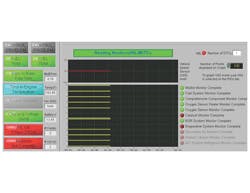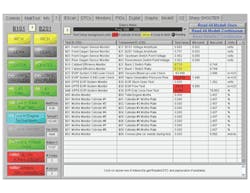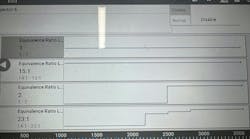The customer came in with a complaint that his Check Engine light was on. A quick scan easily showed the reason for the complaint. A P0401 (Exhaust Gas Recirculation (EGR) Insufficient Flow) code was found when I checked using Global OBDII’s Mode $03. Certainly by now, you know that I don’t stop there. My next step was just a few cursor clicks away, checking next for any listed test results in Mode $07, more commonly thought of as pending codes stored. Sure enough, two Diagnostic Trouble Codes (DTCs) were found: a P0300 (Random Misfire) and P0308 (Cylinder 8 Misfire).
If you understand OBDII testing strategy basics, then you know there was one more stop I needed to make before I was ready to tackle the P0401. Backing out of Mode $07, I next Mode $01. Here is where I would verify what onboard monitors (or system self tests) had been completed and which ones may still be pending completion.
Why is that important? Monitors often share systems or individual system components. When any code sets, related monitors may be temporarily suspended pending repair of the failed system or component. There’s a bit more to how monitors work and interact, more than we can tackle in this column, but do a little digging on the Motor Age website and you’ll find plenty of help in understanding it all. For now, I’m looking for any monitors that are listed on my scan tool as Incomplete or Not Ready, indicating that testing for those monitors has been temporarily suspended or that the conditions they needed to complete have not yet been met. In either case, it is possible that they will find a problem and turn the MIL light back on after I send the car home. And unless I make my customer aware of that, I’m the one that’s going to look bad!
Looking at the monitor status, I noticed that both the catalytic converter monitor and the evaporative emissions (EVAP) system monitors were Not Ready. I wasn’t too concerned about the EVAP monitor. They can take a while to run, especially on an older vehicle like this Expedition. The cat monitor, however, was a bit more concerning. Misfire codes, for sure, will suspend this monitor on most all makes. To be safe, I took a snapshot of the screen information to share with the owner and to keep in my shop’s records.
Let’s take a look at what else is on this list to see if any of the information will be useful in diagnosing and predicating what else may fail. The systems/monitors that Mode $06 reports on are the O2 sensors, catalyst, EVAP, EGR and misfire. Now I can zone in on the EGR data looking at what test failed and by how much. The Mode $06 test Test ID (TID) $4A is the DPFE EGR system monitor. The Component ID (CID) $30 is the EGR Flow Test that is part of that monitor, and has a Test Value (result) of -0.616 and a Minimum Limit value of 5.990 (both in Units of in/H2O (inches of water)), failing by a very large margin. When you see such a big spread from the test value to the limit whether it is a minimum or maximum the system is not functioning at all. The EGR also failed for the EGR Duty Cycle Flow test but passes the EGR Stuck Open Test eliminating the possibility that the EGR valve is sticking open.
Other alarming information highlighted in yellow (close to failing) on this Mode $06 list is the catalyst efficiency test, showing both banks are very close to failing. Remember that I had two monitors that were Not Ready”, one of them being the catalyst monitor. This information is telling me that it is a very real possibility that a P0420 and/or P0430 (Catalyst Efficiency Below Threshold) DTC may crop up and illuminate the MIL. I also need to look at another problem on the list that you can see is failing (highlighted in red). TID $25 (EVAP System 0.040 Leak Check), CID $00 (Vapor Generation Pressure Rise) has a Test Value of -63.898 and a Minimum Limit test value of 1.498, also in units of in/H2O. Once again the monitor is “Not Ready” and there is another strong possibility of a DTC when this monitor completes its testing.
With the information provide in Mode $06, I now know exactly what I’m looking for in the EGR system and it’s time to see why the EGR has no flow. Usually no flow indicates that the EGR valve is either not opening up, the EGR passages are clogged or there is a sensor issue. This EGR system uses a Differential Pressure Feedback (DPFE) sensor and a vacuum controlled EGR valve that uses a solenoid to control the vacuum flow to the valve. A quick visual inspection found that the vacuum line nipple going to the valve was cracked.



